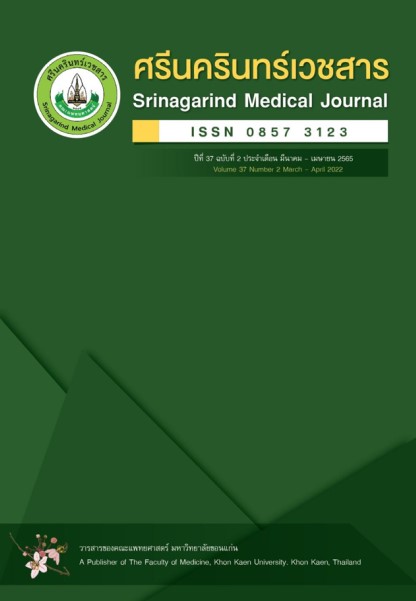ฤทธิ์ต้านแบคทีเรียของสารสกัดใบหญ้าขัดมอญด้วยเอทานอลในการต้านเชื้อแบคทีเรียที่แยกได้จากก้อนนิ่ว
Abstract
Antibacterial activity of Ethanolic Extract of Sida acuta Burm. F. Leaves Against Bacteria Isolated from Stone Matrices
บทคัดย่อ
หลักการและวัตถุประสงค์: อุบัติการณ์ของเชื้อแบคทีเรียที่แยกได้จากผู้ป่วยโรคนิ่วไตมีแนวโน้มดื้อต่อยาต้านจุลชีพหลายชนิดเพิ่มขึ้น สารสกัดจากพืชหลายชนิดมีฤทธิ์ในการต้านแบคทีเรีย การศึกษานี้มีวัตถุประสงค์เพื่อประเมินฤทธิ์ต้านแบคทีเรียของสารสกัดใบหญ้าขัดมอญ (Sida acuta Burm. F.; SA) ด้วยเอทานอล (EESA) ในการต้านเชื้อแบคทีเรียที่แยกได้จากก้อนนิ่วไต
วิธีการศึกษา: ประเมินฤทธิ์ของ EESA ในการต้านเชื้อแบคทีเรีย 2 กลุ่ม ได้แก่ แบคทีเรียสายพันธุ์มาตรฐาน และสายพันธุ์ที่แยกได้จากก้อนนิ่วด้วยวิธี broth microdilution โดยแต่ละกลุ่มประกอบด้วยแบคทีเรียแกรมบวกและแกรมลบอย่างละ 3 สายพันธุ์ และตรวจหาปริมาณฟลาโวนอยด์ทั้งหมดของ EESA
ผลการศึกษา: ค่าความเข้มข้นต่ำสุดของ EESA ที่สามารถยับยั้งการเจริญของแบคทีเรียแกรมบวกทั้งสายพันธุ์มาตรฐานและสายพันธุ์ที่แยกได้จากก้อนนิ่วไต มีค่าอยู่ในช่วง 1-8 มิลลิกรัม/มิลลิลิตร ส่วนแบคทีเรียแกรมลบทั้งสองกลุ่มมีค่าอยู่ในช่วง 16-32 มิลลิกรัม/มิลลิลิตร โดย EESA มีฤทธิ์ยับยั้ง Staphylococcus saprophyticus ได้ดีที่สุด และ EESA มีสารฟลาโวนอยด์เป็นส่วนประกอบ
คำสำคัญ: ฤทธิ์ต้านแบคทีเรีย ฟลาโวนอยด์ หญ้าขัดมอญ แบคทีเรีย นิ่วไต
Abstract
Background and Objective: The incidence of multidrug-resistant bacteria isolated from stone matrices of kidney stone patients has increased dramatically. Many plant extracts have been studied for antibacterial activity. Therefore, this study aimed to evaluate the antibacterial activity of the ethanolic extract of Sida acuta Burm. F. leaves (EESA) against bacteria isolated from kidney stone matrices.
Methods: The antibacterial activity of EESA was evaluated against two groups of bacteria, reference strains and clinical strains isolated from stone matrices by using the broth microdilution method. Each group of bacteria included three Gram-positive and three Gram-negative bacteria. Total flavonoid content of EESA was also determined.
Results: The minimum inhibitory concentrations of EESA against both reference and clinical strains for Gram-positive bacteria were in the range of 1-8 mg/mL whereas those of both groups for Gram-negative bacteria were in the range of 16-32 mg/mL. The best inhibitory activity of the EESA was observed against Staphylococcus saprophyticus. The EESA revealed the presence of flavonoids.
Conclusion: The EESA had antibacterial activity and flavonoids. The EESA may be developed as an alternative drug for the prevention and treatment of kidney stone disease with urinary tract infection especially S. saprophyticus.
Keywords: antibacteria, flavonoid, Sida acuta Burm. F., bacteria, kidney stone


